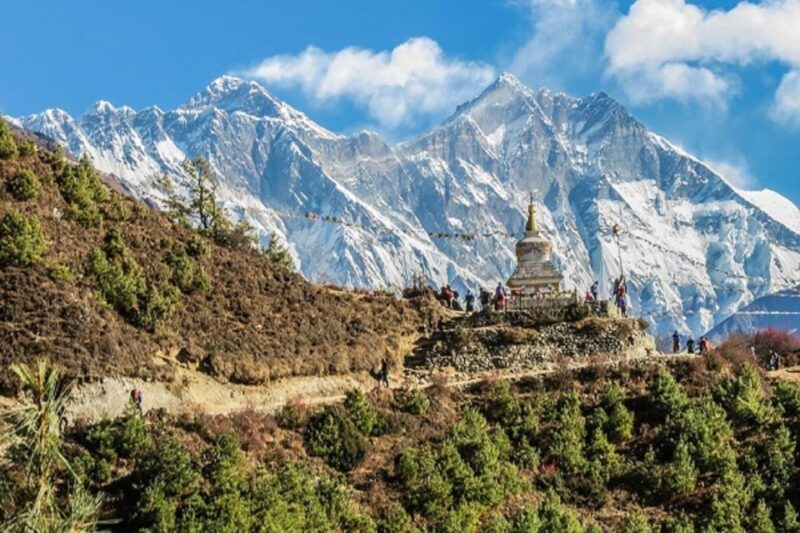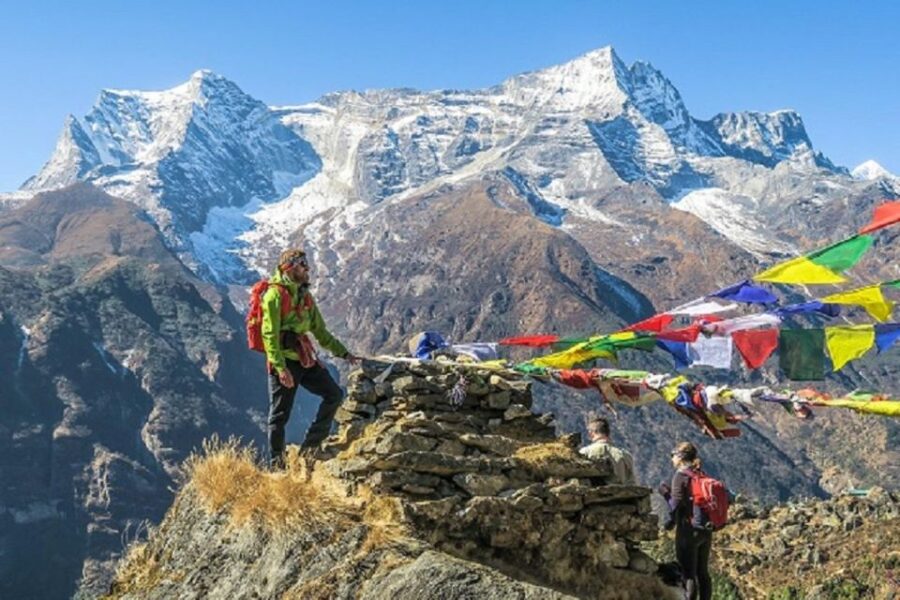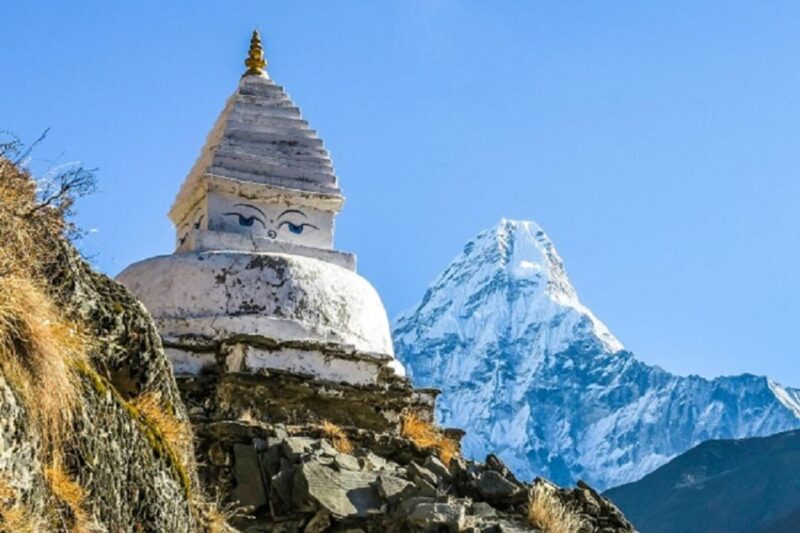Embarking on the Everest Base Camp trek is a once-in-a-lifetime opportunity for adventure-seekers. Over the course of 9 days, trekkers will traverse approximately 130 kilometers, marveling at the Himalayan landscape and seeing Sherpa culture. While the journey presents physical challenges, the rewards are unparalleled – from the exhilaration of reaching Base Camp at 5,364 meters to the warm hospitality found along the way. Whether you’re an experienced hiker or a first-time trekker, this short but unforgettable expedition promises to leave a lasting impression.
Key Points

- The Everest Base Camp trek is a 9-day round trip covering approximately 130 kilometers, starting from Lukla and reaching the base camp at 5,364 meters.
- The trek offers stunning Himalayan views, rich Sherpa culture, and high-altitude endurance tests, culminating in the awe-inspiring Khumbu Icefall.
- Proper acclimatization is crucial, with stops in Namche Bazaar and Dingboche to adjust to the high altitude and diverse landscapes.
- Accommodations are in traditional Nepali tea houses, featuring local Nepali cuisine and friendly Sherpa hospitality.
- The trek requires essential trekking gear, including warm, layered clothing, sturdy hiking boots, and necessary permits and support from licensed guides and porters.
Trek Overview

The Everest Base Camp Trek is a majestic journey that takes trekkers to an astonishing elevation of 17,600 feet, offering stunning views of the Himalayan landscape, including the iconic Mount Everest, as well as Lhotse and Nuptse.
Adventurers will enjoy the rich Sherpa culture, experiencing their renowned hospitality.
The thrilling trails and high-altitude challenges present an exhilarating test of endurance.
Trekkers will witness the awe-inspiring Khumbu Icefall, a glacial masterpiece that serves as the gateway to the Everest Base Camp.
This iconic trek captivates outdoor enthusiasts from around the world, promising an unforgettable spiritual and cultural journey through the majestic Himalayas.
Ready to hit more trails? More hiking adventures we feature in Pheriche
Itinerary and Stops

Over the course of 9 days, trekkers embark on a round trip journey of approximately 130 kilometers, starting from the town of Lukla, Nepal, which can be reached by a scenic flight from Kathmandu.
The first day is a 3-hour trek to Phakding at 2,610 meters. The next day, trekkers make their way to Namche Bazaar, the gateway to the Everest region, in 6-7 hours.
After an acclimatization day, the trek continues to Tengboche, Dingboche, and Lobuche, gaining altitude gradually.
The final push to Everest Base Camp at 5,364 meters takes 7-8 hours, and the return journey follows the same route, allowing for proper acclimatization.
Trekking Challenges
Navigating the Everest Base Camp Trek presents a range of challenges for trekkers, from the necessity of proper acclimatization to the treacherous terrain and unpredictable weather conditions.
Acclimatization is crucial, with stops in Namche Bazaar and Dingboche to allow the body to adjust to the high altitude.
Trekkers must also be prepared to traverse diverse landscapes, from suspension bridges over raging rivers to steep, rocky ascents.
The final push to Everest Base Camp involves a challenging climb over the Khumbu Glacier, a glacial masterpiece that demands caution and skill.
Throughout the journey, trekkers must remain vigilant, as the Himalayan environment can be unpredictable, with sudden changes in weather that can impact the trek.
Accommodation and Meals
Along the Everest Base Camp trek, trekkers can expect a mix of simple yet comfortable accommodations in traditional Nepali tea houses, providing respite from the arduous journey.
These tea houses offer twin-sharing rooms, with basic amenities like beds, blankets, and shared bathroom facilities.
The meals served are wholesome and hearty, typically featuring local Nepali dishes like dal (lentil stew), rice, and seasonal vegetables. Trekkers can also enjoy hot beverages like tea and coffee to warm up after a long day on the trail.
The tea house experience immerses travelers in the local culture, allowing them to interact with the friendly Sherpa people and gain deeper insights into their way of life.
More Great Tours NearbyPermits and Support
Trekkers planning the Everest Base Camp adventure must obtain the necessary permits and support to ensure a safe and successful journey.
The trek includes a flight ticket from Kathmandu to Lukla, which is the starting point. Travelers will also have the guidance of a licensed English-speaking guide throughout the trek. Accommodation in standard tea houses and meals are included, along with porter support to carry bags.
Necessary trekking permits are provided, and an overnight stay in Kathmandu before and after the trek is arranged. This comprehensive support system allows trekkers to focus on the exhilarating experience without worrying about logistics.
With the right permits and assistance, adventurers can fully enjoy the Himalayan splendor.
Gear and Equipment
Proper trekking gear and equipment are essential for a successful Everest Base Camp trek, as the high-altitude terrain and unpredictable weather conditions demand specialized attire and gear.
Hikers should pack warm, layered clothing, including moisture-wicking base layers, insulating mid-layers, and weatherproof outer shells.
Sturdy, broken-in hiking boots with good traction are a must, as is a comfortable backpack with a hip belt for carrying supplies.
Other key items include a warm hat, gloves, sunglasses, and trekking poles to assist with balance and stability on uneven ground.
Hikers should also bring a water bottle, snacks, and a headlamp for navigating in low light.
Getting to Lukla
The journey to Everest Base Camp begins with a scenic flight from Kathmandu to Lukla, the starting point of the trek. This 30-minute flight offers breathtaking views of the Himalayan landscape, including the iconic peaks of Everest, Lhotse, and Nuptse.
Here are three key things to know about getting to Lukla:
-
Flights operate in the early morning to avoid potential weather delays later in the day.
-
The runway in Lukla is short and steep, requiring skilled pilots to land safely.
-
Travelers should be prepared for potential delays or cancellations due to weather conditions, as flights can be affected by the unpredictable mountain climate.
With the right preparation, this flight sets the stage for an unforgettable journey through the Himalayas.
Cultural Immersion
Along the Everest Base Camp trek, culture awaits as trekkers traverse through the heartland of the Sherpa people, experiencing their vibrant traditions, welcoming hospitality, and deep spiritual connection to the Himalayas.
At the bustling Namche Bazaar, a hub of Sherpa culture, visitors can explore monasteries, sample local cuisine, and interact with the friendly locals.
Further along the route, trekkers will witness the awe-inspiring Tengboche Monastery, a spiritual center where they can observe Buddhist rituals and gain insights into the Sherpa way of life.
This cultural exchange enriches the trekking experience, leaving a lasting impression and a deeper understanding of the Himalayan community.
Frequently Asked Questions
What Is the Best Time of Year to Trek to Everest Base Camp?
The best time to trek to Everest Base Camp is typically during the spring (March to May) or autumn (September to November) seasons. These times offer the most favorable weather conditions and clear mountain views for trekkers.
Is a Guide Required for the Everest Base Camp Trek?
While a guide is not strictly required for the Everest Base Camp trek, it’s highly recommended. A knowledgeable guide can ensure proper acclimatization, navigate tricky trails, and provide cultural insights, enhancing the overall trekking experience.
How Difficult Is the Trek to Everest Base Camp?
The trek to Everest Base Camp is moderately difficult, involving high-altitude hiking, navigation through glacial terrain, and rigorous acclimatization. It requires a good level of fitness and preparation, but is achievable for trekkers with proper guidance and support.
Can I Drink the Water Along the Everest Base Camp Trek?
You generally shouldn’t drink the water along the Everest Base Camp trek without first treating it. The water can contain bacteria and parasites that can cause illness. It’s best to use a water filter or purification tablets to make the water safe to drink.
What Type of Training Is Recommended for the Everest Base Camp Trek?
Comprehensive training is recommended for the Everest Base Camp trek. Aerobic exercises, strength training, and high-altitude acclimatization are crucial to build endurance and handle the physical demands. Proper preparation can ensure a safe and enjoyable trekking experience.
Recap
The Everest Base Camp: a Short Trek offers a remarkable journey through the majestic Himalayas.
Trekkers will be rewarded with breathtaking vistas, a taste of Sherpa culture, and the thrill of reaching the iconic base camp.
With proper preparation and the right equipment, this challenging yet unforgettable experience is within reach for adventurous travelers seeking an unparalleled Himalayan adventure.
You can check availability for your dates here:More Hiking & Trekking Tours in Pheriche
More Tour Reviews in Pheriche
Not for you? Here's more things to do in Pheriche we have recnetly reviewed
- 2 Best Guided Tours In Pheriche
- 3 Best Tours In Pheriche
- 5 Best Helicopter Flights And Tours In Pheriche
- 17 Best Hiking And Trekking Tours In Pheriche
- Everest Base Camp Trek 14 Days
- From Lukla: 10 Day Everest Base Camp With Kalapatthar Trek
- Everest Base Camp With Kalapatthar Guided Trek 12 Days
- From Lukla: 10 Day Everest Base Camp With Kalapatthar Trek
- Kathmandu: 12-Day Everest Base Camp Trek
- From Kathmandu: 12DAY Everest Base Camp Trek
- From Lukla: 11 Day Everest Base Camp With Kala Patthar Trek
- Everest Base Camp Trek- 14 Days
